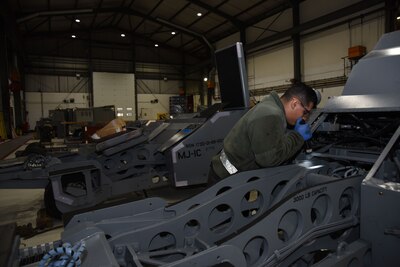By Marine Corps Cpl. Dallas Johnson Marine Forces Reserve
CAMP GRAYLING, Mich., Feb. 12, 2018 — Marine Corps
Reservists with Fox Company, 4th Tank Battalion, 4th Marine Division, are
testing their ability to conduct operations in the deep snow and extreme cold
of the harsh northern Michigan winter here during Exercise Winter Break ‘18,
Feb. 6-14.
This was the first time the tank company, which is based at
Camp Lejeune, North Carolina, conducted training specifically designed to
improve their ability to operate in cold weather environments.
“Especially for Fox Company, this training gives us
something else to work on outside of Camp Lejeune,” said Marine Corps Gunnery
Sgt. Kyle Lloyd, the company’s master gunner. “It tasks us to an environment
the Marines don’t normally operate in.”
The Marines began with land navigation, formations, night
driving and a class on concealment and camouflage, which is more challenging in
a snowy environment, particularly for an armored vehicle as large as the Abrams
M1A1 tank. Throughout the week, Marines advanced to platoon offensive and
defensive operations, then company level operations.
For many of the Marines taking part in the exercise,
battling the cold was only part of the experience.
‘Different Environment’
“Being out here is definitely cold, but it gets us out and
into a different environment,” said Marine Corps Sgt. Michael Colbert, a tank
crewman. “We’re able to challenge ourselves on how we operate as a unit.
Whether it’s hot, cold or raining, it doesn’t matter what the environment
really is. Here in the Marine Corps, you learn how to lead, how to organize and
be productive.”
Friction was built into the training exercise, but there
were also unexpected challenges.
“Cold weather affects everything we do,” said Marine Corps
Capt. Andrew Bender, the company commander. “In short, it has to be more
deliberate. A lot of what we do is limited by weather that routinely gets down
to single digits or below zero. In addition, the thought process -- simply
thinking and responding to unknown uncertainties, friction points and chaos
tends to be slower in Marines who aren’t acclimatized to an environment of such
an extreme nature.”
Winter Break ‘18 was also an opportunity for Marines to validate
their cold weather equipment. The M1A1 tank uses rubber pads on the track to
provide adhesive friction. But the rubber pads lose traction under icy
conditions in steep terrain, just like automobile tires lose traction on icy
roads in winter. The Marines installed "ice cleats" on every fifth
shoe of the track of their M1A1 tanks to give more "bite" and to
provide traction on icy and hilly terrain.
Fox Company, a Marine Corps Forces Reserve unit, regularly
trains with and augments 2nd Tank Battalion, 2nd Marine Division, which is also
located at Camp Lejeune.
“For the bigger picture, for the Marine Corps, this is
allowing us to go through and validate the training and readiness standards for
the tank community for both Reserve and active-duty Marines,” Lloyd said.
“We’re ensuring that not only are we training Reserve Marines to what ongoing
threats are, but we’re showing the active component what’s going on as well.”









